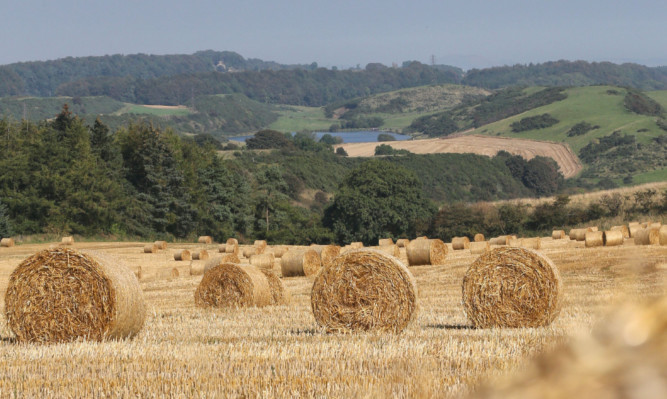One of the most difficult areas for the farming industry to consider during the whole referendum campaign has been Scotland’s likely status within the European Union.
A Yes vote would see us out, but for how long?
A No vote would see us in, but for how long?
Given that 70% of Scottish farming’s net income of late has come from the EU by means of CAP support payments, an individual’s view on which scenario will become reality could sway the way they vote.
There are actually four possibilities.
* The first would follow a No vote and see the status quo continue.
* The second would also follow a No vote but would see the UK come out of Europe permanently after a 2017 referendum.
* The third follows a Yes vote and sees an independent Scotland cast into the wilderness for years until it gains its own EU membership.
* The fourth sees an independent Scotland back in back in the EU immediately it leaves the UK in spring 2016.
This is, as we have heard ad infinitum from Alex Salmond, his preferred option and one which he thinks is the only one conceivable.
Of course the third and fourth options have further sub-options.
Scotland could be out in the wilderness trying to get back into the EU while the remainder of the UK is busily voting itself out.
Or Scotland could be back in as an EU member with rUK as a fellow member state.
It is a sort of giant hokey cokey of the nations. Pity then the farmer trying to work out the best option.
For many, of course, gaining maximum support payment is far from the most important aspect of tomorrow’s referendum but it is still something to consider.
The options are there, but which one would be best for Scottish farming?
A closer look is given below.
* A No vote with the status quo of continued EU membership
The CAP as agreed will carry on until 2020 with a mid-term review in 2016 looking at internal convergence.
If this is carried out fairly it would see a levelling of support payments across the UK’s administrations.
A Defra minister would continue to lead the
UK delegations to the
EU.
It is in essence the devil we know, and maybe not the worst option.
The UK does have the clout to go eyeball to eyeball with the big beasts of the EU jungle such as France and Germany.
A UK-driven initiative for changes to the way the EU is run might make life easier.
* A No vote but the UK out of the EU after 2017.
This would indeed be uncharted waters.
A UK government of whatever colour would almost certainly still want to support its capability to grow food, despite talk especially from former Defra Secretary Owen Paterson of aspiring to a subsidy-free agriculture.
Most farmers would go with that if commodity prices were high enough. No more being beholden to the public purse and no more cross-compliance.
It might be quite attractive if it was linked to a US-style state-funded crop insurance scheme.
That is essentially what happened in the UK before 1972, except it was called the deficiency payment scheme.
This writer can just recall it, and it worked well enough.
It would be difficult to make it WTO-compliant, of course, but the trade talks are now so badly stalled that they may soon be outflanked by events.
There is another point
on this option it might very well never exist. It needs the right combination of political power in the UK to even call an EU referendum, and that is far from certain.
It is what Donald Rumsfeld would have called an “unknown unknown”.
* A Yes vote with Scotland out of the EU for many years.
This is a more clear-cut possibility than an exit after an EU referendum.
The process would start on Friday with Scotland heading for the exit.
It must be wildly optimistic to think that Scotland would be back in before it left. This is the so-called seamless transition. It seems unlikely, though.
It has taken six years to arrange a new CAP, after all.
The EU doesn’t have a reputation for moving quickly, and there will be opposition.
On Tuesday night’s Newsnight the Spanish Europe Minister,Inigo Menez de Vigo, said it would take many years for Scotland to negotiate entry. There were 35 charters to be agreed under Article 49.
Then the European Parliament would need to approve the accession.
Finally the biggest hurdle of all would have to be overcome with all 28 member states having to agree unanimously.
Nothing in Mr Menez de Vigo’s demeanour suggested that Spain would make this an easy process.
Spain, Italy, Belgium, France and Denmark all have regions which would like to be independent.
* A Yes vote with Scotland back in the EU very quickly.
This of course is Mr Salmond’s dream option as it would put Scottish ministers at the negotiating table in their own right.
But how effective would they be, given that they would represent only 1% of the EU’s population?
It has been claimed that had Scotland been independent its farmers would have gained 1bn euros more in support payments over the next five years. That assumes that Richard Lochhead would have been able to negotiate such an outcome.
He might, but he would need to be very astute and able to conceal that Scotland’s CAP payment already amounts to 145 euros per head of population compared to an average of 90 euros over the rest of Europe.
Accepting the euro as a currency would also be a very likely condition.
This would mean Scotland using a different currency to rUK, which would continue with the pound regardless of whether it was an EU member or not.
There would be no UK rebate to ease the cost of EU membership.
